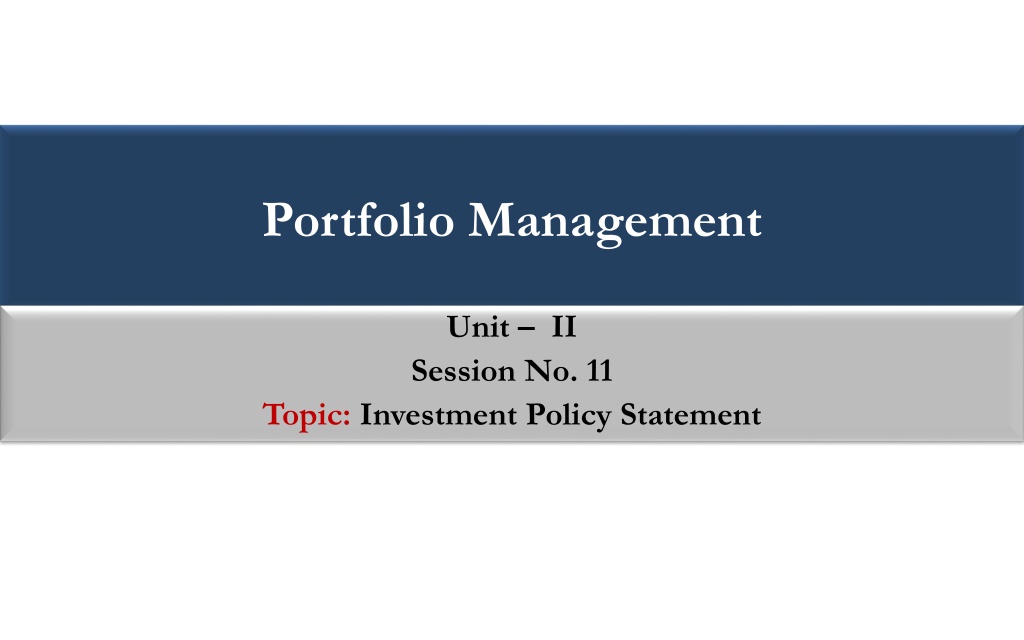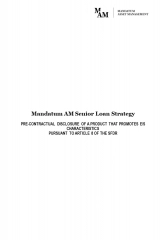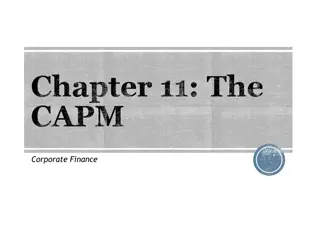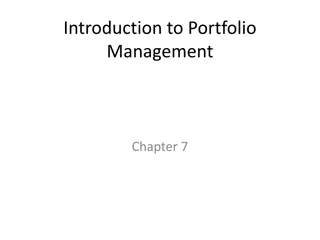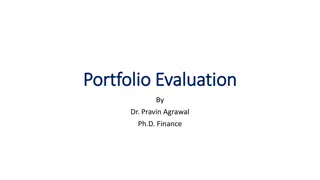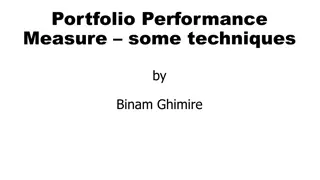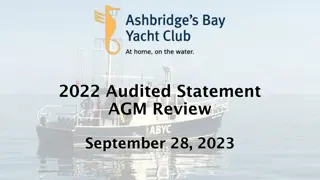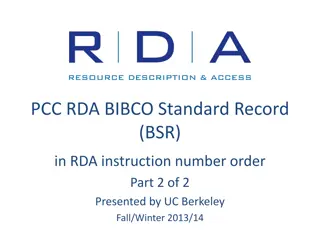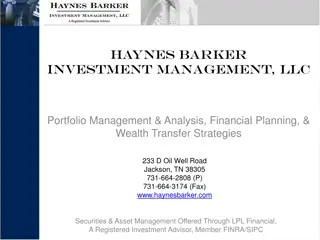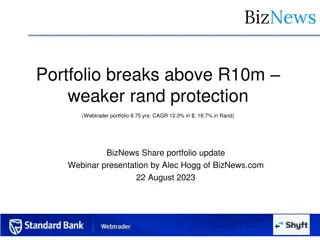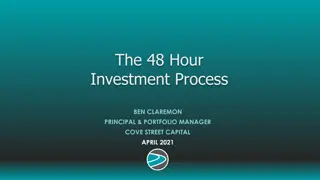Understanding Investment Policy Statements in Portfolio Management
Investment Policy Statements (IPS) are crucial documents that outline the financial objectives, risk tolerance, and constraints of an investor-adviser relationship. It guides portfolio construction, monitoring, and review, ensuring a mutually agreed basis for decision-making. Constructing an effective IPS involves reconciling investment goals, constraints, and risk tolerance, protecting both parties and serving as a portable understanding document.
Download Presentation

Please find below an Image/Link to download the presentation.
The content on the website is provided AS IS for your information and personal use only. It may not be sold, licensed, or shared on other websites without obtaining consent from the author. Download presentation by click this link. If you encounter any issues during the download, it is possible that the publisher has removed the file from their server.
E N D
Presentation Transcript
Portfolio Management Unit II Session No. 11 Topic: Investment Policy Statement
Session Plan Recap the Previous Session Investment Policy Statement Return and Risk Objectives Constraints Summarizing and Q & A
Recap What is Traditional Finance? What is the consequence of traditional assumptions on individual economic behavior? What is Behavioral finance? How individuals are taking decisions based on behavioral finance? How the personality typing bridges the difference between traditional finance and behavioral finance?
Investment Policy Statement The IPS is a client-specific summation of the circumstances, objectives, constraints, and policies that govern the relationship between adviser and investor. A well-constructed IPS presents the investor s financial objectives, the degree of risk he or she is willing to take, and any relevant investment constraints that the adviser must consider. It also sets operational guidelines for constructing a portfolio. The IPS establishes a mutually agreed-upon basis for portfolio monitoring and review.
Investment Policy Statement Constructing an IPS is a dynamic process Investment adviser must identify and then reconcile investment objectives, portfolio constraints, and risk tolerance of his/her client. An IPS is portable and easily understood by other advisers. The IPS serves as a document of understanding. It protects both the adviser and the individual investor Elements Setting Return and Risk Objectives Constraints
Investment Policy Statement 1. Setting Return and Risk Objectives As one reconciles investment goals with risk tolerance, however, client-specific investment parameters emerge. 1.1. Return Objective The process of identifying an investor s desired and required returns should take place concurrently with the discussion of risk tolerance. Return requirement is different from return desire. Return requirements are generally driven by annual spending and relatively long-term saving goals.
Investment Policy Statement 1.1. Return Objective Goals have often been classified as income requirements and growth requirements. As an alternative to growth and income, a total return approach to setting return requirements looks first at the individual s investment goals and then identifies the annual after-tax portfolio return necessary to meet those goals. An investor s return objectives are inconsistent with his risk tolerance, a resolution must be found.
Investment Policy Statement 1. Setting Return and Risk Objectives An individual s risk objective, or overall risk tolerance, is a function of both ability to take risk and willingness to take risk. 1.2. Risk Objective a. Ability to Take Risk Assessing an individual s ability to take risk is suited to quantitative measurement. It is generally the investment adviser who defines the terms of the analysis and then must explain the results. The investor s financial needs and goals, Importance of these goals, investment shortfall
Investment Policy Statement 1. Setting Return and Risk Objectives 1.2. Risk Objective b. Willingness to Take Risk Investor willingness involves a more subjective assessment. No absolute measure of willingness exists Psychological profiling provides estimates of an individual s willingness to take risk, but final determination remains an imprecise science. It may, in fact, be necessary that investors have personal experience with significant losses as well as gains before a productive discussion of risk tolerance with them is possible.
Investment Policy Statement 2. Constraints The IPS should identify all economic and operational constraints on the investment portfolio. Portfolio constraints generally fall into one of five categories: Liquidity Time horizon Taxes Legal and regulatory environment Unique circumstances
Investment Policy Statement Liquidity: Investment portfolio s ability to efficiently meet an investor s anticipated and unanticipated demands for cash distributions. Characteristics of its holdings determine a portfolio s liquidity: Transaction costs. Transaction costs may include brokerage fees, bid ask spread, price impact or simply the time and opportunity cost of finding a buyer. Price volatility. If the market itself is inherently volatile, however, the asset s contribution to portfolio liquidity (the ability to meet cash-flow needs) is limited. Reasons for Liquidity Requirements: 1. Ongoing expenses; 2. Emergency reserves 3. Negative liquidity events
Investment Policy Statement Time Horizon No universal definition of long-term or short-term exists Horizons of less than 3 years as relatively short term, between 3 to 15 years as intermediate and above 15 became long-term. The investor faces a single (unique nature)- or multistage horizon (constraint most often). Stage-of-life shortens gradually as investors move through the various stages of life. Taxes The issue of taxes is perhaps the most universal and complex investment constraint to be found in private portfolio management. Taxation of income or property is a global reality and poses a significant challenge to wealth accumulation and transfer. General categories: Income tax, Gains tax, Wealth transfer tax, and Property tax
Investment Policy Statement Legal and Regulatory Environment Legal and regulatory constraints most frequently involve taxation and the transfer of personal property ownership. Vary greatly from country to country and change frequently. Achieving investment objectives within the constraints of a given jurisdiction frequently requires consultation with local experts, including tax accountants and estate-planning attorneys. A portfolio manager s must be careful to avoid giving advice that would constitute the practice of law.
Investment Policy Statement Unique Circumstances Individual investors often present their investment advisers with a wide range of unique circumstances Such constraints might include guidelines for social or special-purpose investing, assets legally restricted from sale, and privacy concerns. It is also appropriate to list here any assets held outside the investment portfolio
Summarizing Distinguish between return requirements and return tolerance. What is total return approach? What are the investor s financial needs and goals both long-term and short- term? How important are these goals? Liquidity requirements generally arise but sometimes it fall. Why? Why elderly investors are consistent with a single stage time horizon? List the different categories of taxes related to the individual Investor.
